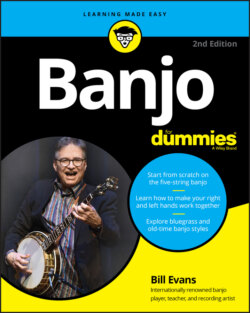Читать книгу Banjo For Dummies - Bill Evans - Страница 48
Sitting down to play
ОглавлениеHow you hold your banjo while sitting down is determined by how much you need to see the banjo fingerboard while you're playing. Some players use the position dots on the top side of the banjo neck to keep track of where they are on the banjo neck and don't actually look at the fingerboard directly at all, but most players prefer to actually see what their flying fretting fingers are doing.
Another aspect of finding a comfortable playing posture is to experiment with different neck angles (the banjo neck that is, not your neck!). New players are often so concerned with seeing the fingerboard that they raise the neck to bring it closer to their eyes. Too much of this can lead to some technique problems in both the left and right hands. My advice is to angle the neck such that the peghead is no higher than eye level.
You also want to find a chair around the house that allows you to comfortably sit upright, provides you with some back support (if you need it), and allows your arms to move freely (no recliners allowed!). When I'm playing around the house, I like to use an adjustable office chair with the side arms removed. As you sit, position the banjo so that you're able to see the fingerboard and the banjo head, but don't let the banjo be so low in your lap that you have to reach far around the neck to fret with the left hand.
After you've actually started to play banjo, take a look at photos of some of your favorite players and experiment with different neck angles to see what works the best for you. Figure 3-4 shows three different ways of holding the banjo while sitting. Note that the middle player, Jody, rests the banjo on his right thigh and doesn't need a strap at all. Erin (left) and yours truly (right) prefer straps on our heavier resonator banjos.
Photographs by Anne Hamersky
FIGURE 3-4: Erin (a), Jody (b), and Bill (c) show three different ways to enjoy playing the banjo while sitting.
